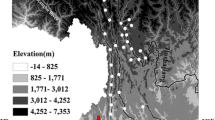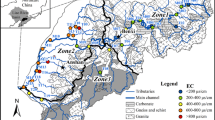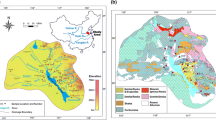Abstract
River, rain and spring water samples from a region covered in “Shirasu” ignimbrite were collected on Kyushu Island, Japan. The analytical results were subjected to multivariate statistical analysis and stoichiometric calculation to understand the geographical distribution of chemical components in water and to extract geochemical underlying factors. The multivariate statistical analysis showed that the river-water chemistry is only slightly influenced by hot springs or polluted waters, but is highly controlled by weathering of ignimbrite. On the basis of the stoichiometric calculation based on water–rock interaction, the water chemistry was successfully estimated by a simple equation:\({\left[ {{\text{Si}}} \right]}{\text{ = 2}}{\left[ {{\text{Na}}^{{\text{ + }}} } \right]}{\text{ + }}{\left[ {{\text{Mg}}^{{{\text{2 + }}}} } \right]}\) in the upstream area, complemented by \({\left[ {{\text{Si}}} \right]}{\text{ = }}{\left[ {{\text{Na}}^{{\text{ + }}} } \right]}{\text{ - 3}}{\left[ {{\text{K}}^{{\text{ + }}} } \right]}{\text{ + }}{\left[ {{\text{Mg}}^{{{\text{2 + }}}} } \right]}{\text{ - 2}}{\left[ {{\text{Ca}}^{{{\text{2 + }}}} } \right]}\) in the downstream area.
Résumé
Des échantillons de rivières, pluies et sources d’une région recouverte par une ignimbrite « Shirasu » ont été collectés sur l’île de Kyushu au Japon. Les résultats analytiques ont été traités suivant différentes techniques d’analyses statistiques multivariées ainsi que par des approches stockiométriques, pour comprendre la distribution géographique des composants chimiques de l’eau et en extraire les facteurs géochimiques principaux. Les analyses statistiques multivariées ont montré que l’hydrochimie de la rivière est faiblement influencée par les sources chaudes et les eaux polluées, mais est d’un autre côté assez bien contrôlée par l’altération de l’ignimbrite. Sur base des calculs stoechiométriques reposant sur l’interaction eau-roche, la chimie de l’eau a été estimée avec succès suivant une simple équation : [Si] = 2 [Na+] + [Mg2+] dans la partie amont, complétée par [Si] = [Na+] – 3 [K+] + [Mg2+] – 2 [Ca2+] dans la partie avale du cours d’eau.
Resumen
Se tomaron muestras de agua en manantial, lluvia, y río de una región de ignimbrita “Shirasu” en la Isla Kyushu, Japón. Se corrieron análisis estadísticos multivariables en los resultados analíticos de las muestras y se realizaron cálculos estoquiométricos para entender la distribución geográfica de los componentes químicos en el agua y para extraer los factores geoquímicos subyacentes. Los análisis estadísticos multivariables muestran que la química de agua de río está únicamente ligeramente influida por fuentes termales o aguas contaminadas, pero que tiene un fuerte control por el intemperismo de las ignimbritas. Basado en cálculos estoquiométricos derivados de la interacción agua-roca se estimó exitosamente la química del agua mediante una ecuación simple: [Si] = 2 [Na+] + [Mg2+] en el área aguas arriba, complementada con [Si] = [Na+] – 3 [K+] + [Mg2+] – 2 [Ca2+] en el área aguas abajo.







Similar content being viewed by others
References
Anazawa K, Ohmori H (2005) The hydrochemistry of surface waters in andesitic volcanic area, Norikura volcano, central Japan. Chemosphere 59:605–615
Anazawa K, Yoshida M (1996) Multivariate analysis of Japanese volcanic rocks: volatile and major elements. Geochem J 30:355–372
Berner RA (1971) Principles of chemical sedimentology. McGraw-Hill, New York, p 240
Brown CE (1998) Applied multivariate statistics in geohydrology and related sciences. Springer-Verlag, Berlin Heidelberg New York
Burrough PA, Van Gaans PFM, Hootsmans R (1997) Continuous classification in soil survey: spatial correlation, confusion and boundaries. Geoderma 77:115–135
Davis JC (1986) Statistics and data analysis in geology. Wiley, New York, pp 468–574
De Gruijter JJ, Walvoort DJJ, Van Gaans PFM (1997) Continuous soil maps: a fuzzy set approach to bridge the gap between aggregation levels of process and distribution models. Geoderma 77:169–195
Fujita S, Sakamoto H (2001) Geochemical interpretation on hydrothermal system in Kagoshima City and its northern area. J Balneological Soc Japan (Onsenkagaku) 51:11–20
Garrels RM (1967) Genesis of some groundwaters from igneous rocks. In: Abelson PH (ed) Researches in geochemistry, vol 2. Wiley, New York, 405–420 pp
Garrels RM, Christ CL (1965) Solutions, minerals, and equiliburia. Harper and Row, San Francisco, CA, 450 pp
Garrels RM, Mackenzie FT (1967) Origin of the chemical composition of springs and lakes, in equilibrium concepts in natural water systems. In: Gould RF (ed) Advances in chemistry, 67. American Chemical Society, Washington, DC, pp 222–224
Goldich S (1938) A study in rock weathering. J Geol 46:17–58
Helgeson HC, Delany JM, Nesbitt HW, Bird DK (1978) Summary and critique of the thermodynamic properties of rock-forming minerals. Am J Sci 278–A
Iwatsuki T, Yoshida H (1999) Groundwater chemistry and fracture mineralogy in the basement granitic rock in the Tono uranium mine area, Gifu Prefecture, Japan: groundwater composition, Eh evolution analysis by fracture filling minerals. Geochem J 33:19–32
Johnson R, Wichern D (2002) Applied multivariate statistical analysis. Prentice Hall, Englewood Cliffs, NJ
Kamei G, Yusa Y, Arai T (2000) A natural analogue of nuclear waste glass in compacted bentonite. Appl Geochem 15:141–155
Kawakami T (1996) Research on the processes which determine the acid-base status of the extremely diluted lakes in the Norikura alpine area. University of Tokyo, Japan
Kobayashi J (1961) A chemical study on the average quality and characteristics of river waters of Japan. Nogaku Kenkyu (Okayama University) 48:63–106
Lauria DC, Godoy JM (2002) Abnormal high natural radium concentration in surface waters. J Environ Radioact 61:159–168
Reimann C, Filzmoser P, Garrett RG (2002) Factor analysis applied to regional geochemical data: problems and possibilities. Appl Geochem 17:185–206
Sasamoto H, Yui M, Arthur RC (2004) Hydrochemical characteristics and groundwater evolution modeling in sedimentary rocks of the Tono mine, Japan. Phys Chem Earth 29:43–54
Singh KP, Malik A, Sinha S (2005) Water quality assessment and apportionment of pollution sources of Gomti River (India) using multivariate statistical techniques: a case study. Analytica Chimica Acta 538:355–374
Spijker J, Van Gaans PFM, Vriend SP (2005) Natural and anthropogenic patterns of covariance and spatial variability of minor and trace elements in agricultural topsoil. Geoderma 127:24–35
Van Helvoort PJ, Van Gaans PFM (2003) Sequential factor analysis as an alternative approach to standard factor analysis. Geochim Cosmochim Acta 67:A510–A510
Vega M, Pardo R, Barrado E, Dcban L (1998) Assessment of seasonal and polluting effects on the quality of river water by exploratory data analysis. Water Res 32:3581–3592
Yokoyama S (1999) Rapid formation of river terraces in non-welded ignimbrite along the Hishida River, Kyushu, Japan. Geomorphology 30:291–304
Acknowledgements
We thank Mr. Hisanori ARAYA, Ms. Yoko ISHIDA and Mr. Takuji KIYOHARA, Department of Earth and Environmental Sciences, Kagoshima University, for their cooperation during the sample collections. The authors gratefully acknowledge the help of Ms. Jeneper Lo, Graduate School of Science and Engineering, Kagoshima University, for critical discussions and helpful comments. The authors would like to express their sincere gratitude and appreciation to Professor Pauline van Gaans-Godfroy, Utrecht University, for her helpful suggestion and critical discussion.
Author information
Authors and Affiliations
Corresponding author
Rights and permissions
About this article
Cite this article
Anazawa, K., Sakamoto, H. & Tomiyasu, T. Influence of ignimbrite on the chemistry of river water in Shirasu plateau, Japan. Hydrogeol J 15, 409–417 (2007). https://doi.org/10.1007/s10040-006-0070-z
Received:
Accepted:
Published:
Issue Date:
DOI: https://doi.org/10.1007/s10040-006-0070-z




